There are many benefits to making homemade beef stock. It’s not only better than anything you’ll buy at the store, it is also budget-friendly and can be used to greatly improve the flavor and quality of any recipe that calls for stock.

This post may contain affiliate links. Our disclosure policy.
I’ve said it before, and I’ll say it again here: using homemade stock, whether beef stock or chicken stock, is a surefire way to elevate your dishes to restaurant quality!
Making homemade beef stock does take some time and patience, but the end result is always worth it.
Want To Save This Recipe?
This beef stock recipe will yield 4 quarts or 16 cups worth of incredibly flavorful stock that you can store in your freezer and use for any recipe that calls for beef stock, such as Guinness beef stew or beef bourguignon.
And since this stock is homemade, it has zero added salt which allows you greater control over sodium levels in the soups and stews and other recipes it’s used for.
Table of Contents
Recipe Ingredients
All ingredients for this recipe are shown in the pic below and special notes are made in this bulleted list to assist you.

- Beef bones. We used beef shin bones which are loaded with marrow. Beef knuckles, oxtail, or other meaty bones are also great. If you find bones that are very clean of any meat, add a few pieces of chuck to the mix. Don’t be afraid to ask your butcher if they have any bones for stock that they can sell you.
- Carrots, celery, and onion. Most homemade stocks are flavored with these three very useful ingredients. There’s no need to dice since they’re being used for flavor only. Feel free to add leeks and mushrooms into your stock too, but don’t add peppers since they tend to impart a bitter flavor.
- Vinegar (not pictured above). A tablespoon of white vinegar helps to break down the collagen speeding up the formation of gelatin and contributing to a richer stock.
- Herbs and spices. Bay leaves, peppercorns, fresh parsley, and fresh thyme add additional flavor.
See the recipe card for full information on ingredients and quantities.
How to make it
Each number corresponds to the numbered written steps below.
- Preheat the oven to 425f and set the rack on the middle level. Place 5 pounds of beef bones on a baking sheet (or two if overcrowded) and drizzle 3 tablespoons of olive oil on top. Use your hands to coat the bones with the oil. Place the bones in the oven and roast for 1 hour turning them at the halfway point (Photo #1).
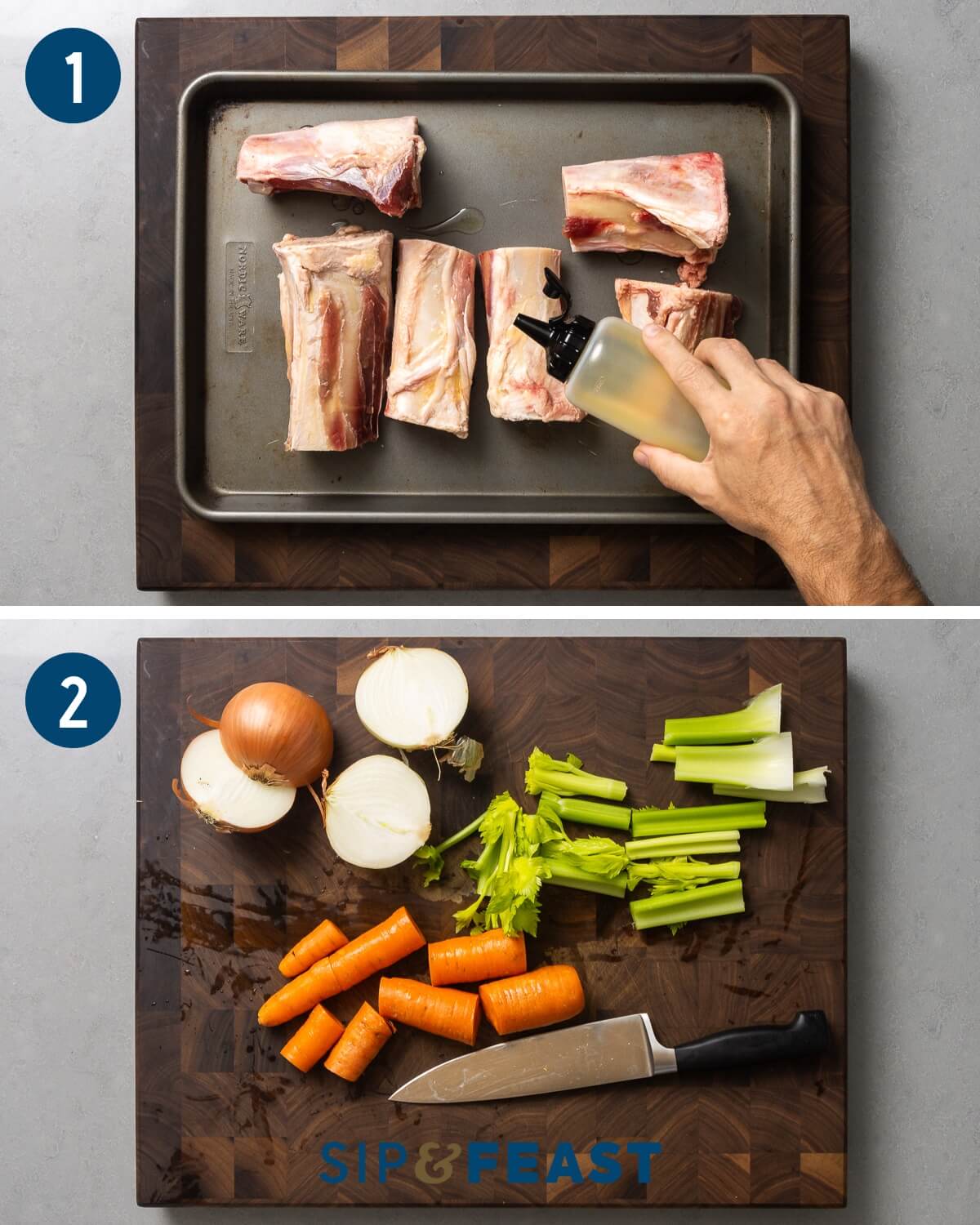
- Slice 2 large carrots and 3 celery ribs into 3-inch pieces. Slice 2 medium yellow onions in half (Photo #2).
- Once the bones are roasted, remove them from the oven and place them in a 16-quart or larger stock pot (Photo #3).

- Pour off and discard the fat from the sheet pan and place the empty pan on the stovetop and turn the heat to medium. Pour 3/4 cup of water into the pan and scrape off all the brown bits with a flat wooden spoon or spatula (Photo #4).
- Pour the liquid from the pan into the stock pot (Photo #5).

- Add the carrots, celery, and onion to the pot along with 5 cloves of garlic, 2 dry bay leaves, 1 bunch of flat-leaf parsley, 15 peppercorns, 10 sprigs of fresh thyme, and 1 tablespoon of white vinegar, then add enough water to cover all the ingredients (Photo #6).
- Bring the pot to a boil over medium-high heat. Once boiling, skim the scum from the top with a large flat spoon or ladle, then turn the heat down to a very low level and allow the stock to simmer for 9-10 hours, skimming the scum every 45-60 minutes (Photo #7).

- After 9-10 hours of simmering, the beef stock will have reduced substantially and you can turn off the heat and strain the stock. Begin by using a pasta spider to gently remove the bones and spent vegetables and herbs (Photo #8).
- Place a sieve or a colander over an empty clean pot and line it with cheesecloth or coffee filters. Begin to ladle or pour the stock (a small pot with a long handle makes a great ladle) into the cheesecloth-lined strainer (Photo #9).
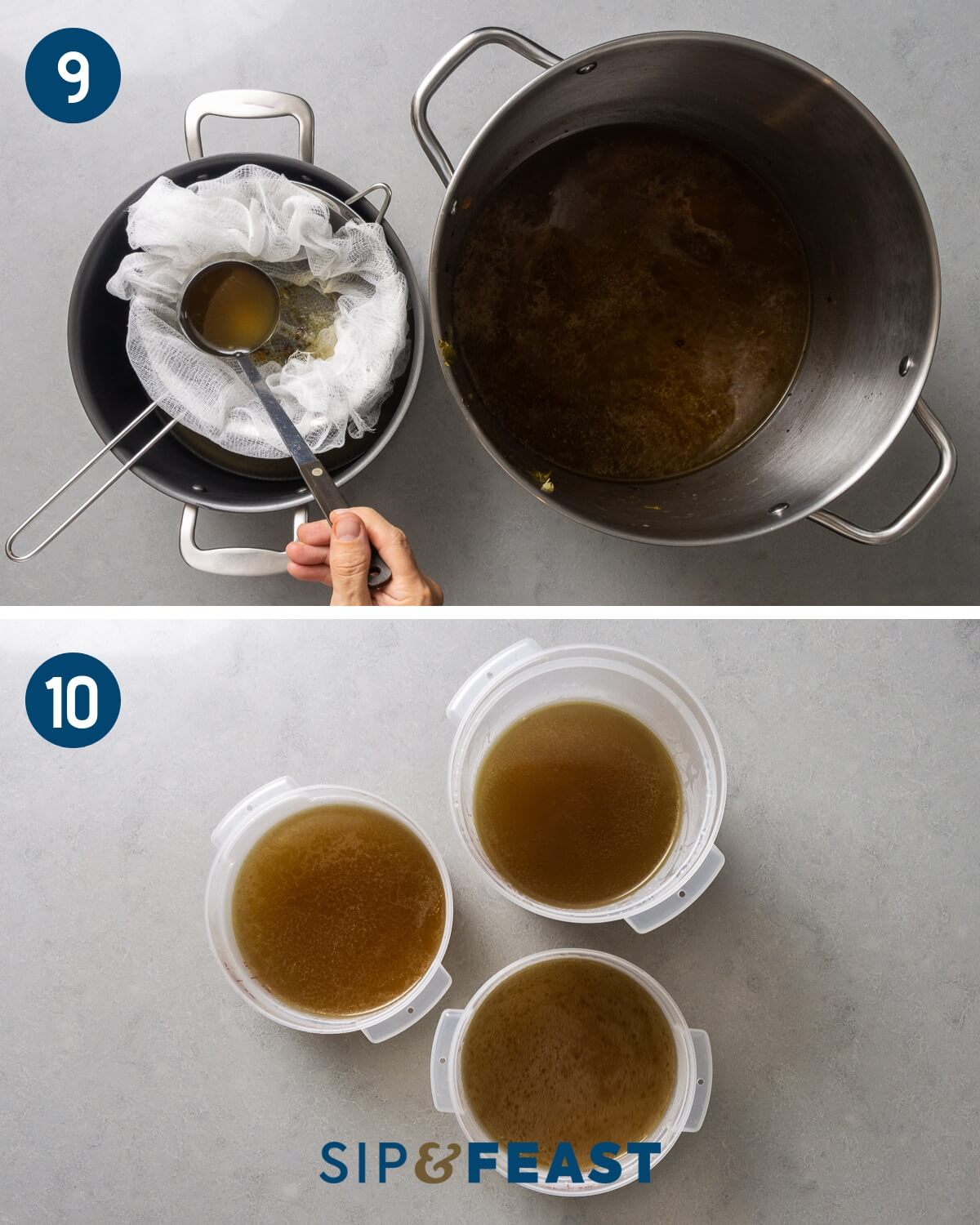
- Once strained, you should be left with about 4 quarts of stock. If you find you have substantially more than that, cook the stock a little longer to reduce. Allow the stock to cool then divide into storage containers. After refrigerating or freezing, a layer of solidified fat will be at the top of each container which will help seal in the flavor of the stock (Photo #10). The fat can either be discarded right before using or saved for another use. See below for storage information.
How to store beef stock
I’ll typically make pots of beef stock and chicken stock right at the end of summer; when the cooler weather comes I’ll often use them on a weekly, if not daily basis.
I recommend using small containers to store the stock. I’ll often store in 1-quart increments, however, smaller amounts are great too.
To store smaller amounts you can ladle the beef stock into ice cube trays or other small containers.
Homemade beef stock can be stored in the refrigerator for up to 5 days, but hold up great in the freezer for up to 6 months.

Top tips
- Talk to your butcher. If you can’t find the beef bones you’re looking for in the refrigerated section of your grocery store, I suggest speaking to the butcher directly. Often they’ll have bones in the back that they can wrap and sell to you. Tell them you’re making a stock and they will likely be able to give you the best bones for stock-making.
- Be gentle. Doing anything to agitate the bones (ie. stirring) while cooking can contribute to a cloudy stock. Resist the urge to stir and simply let the stock simmer for the 9-10 hours, then gently remove the spent ingredients.
- Salt. One of the benefits of making homemade stock is that it does not include salt. I recommend not adding any salt to the stock and do not include it in this beef stock recipe.
- Reuse the bones. A remouillage, or second stock, is a great way to get even more bang for your buck. Simply place the bones along with new veggies/herbs/aromatics into the pot with water and make the second stock.
Beef stock is made with mostly bones and some meat and is simmered longer, while beef broth is typically made with meat and bones. The marrow and collagen in the beef bones contribute to a gelatinous, richer mouthfeel while broth will have a lighter texture. They can be used interchangeably for most recipes.
Roasting the bones first contributes to a richer flavor and color of your stock. Follow the steps in the recipe to deglaze the roasting pan for even more flavor.
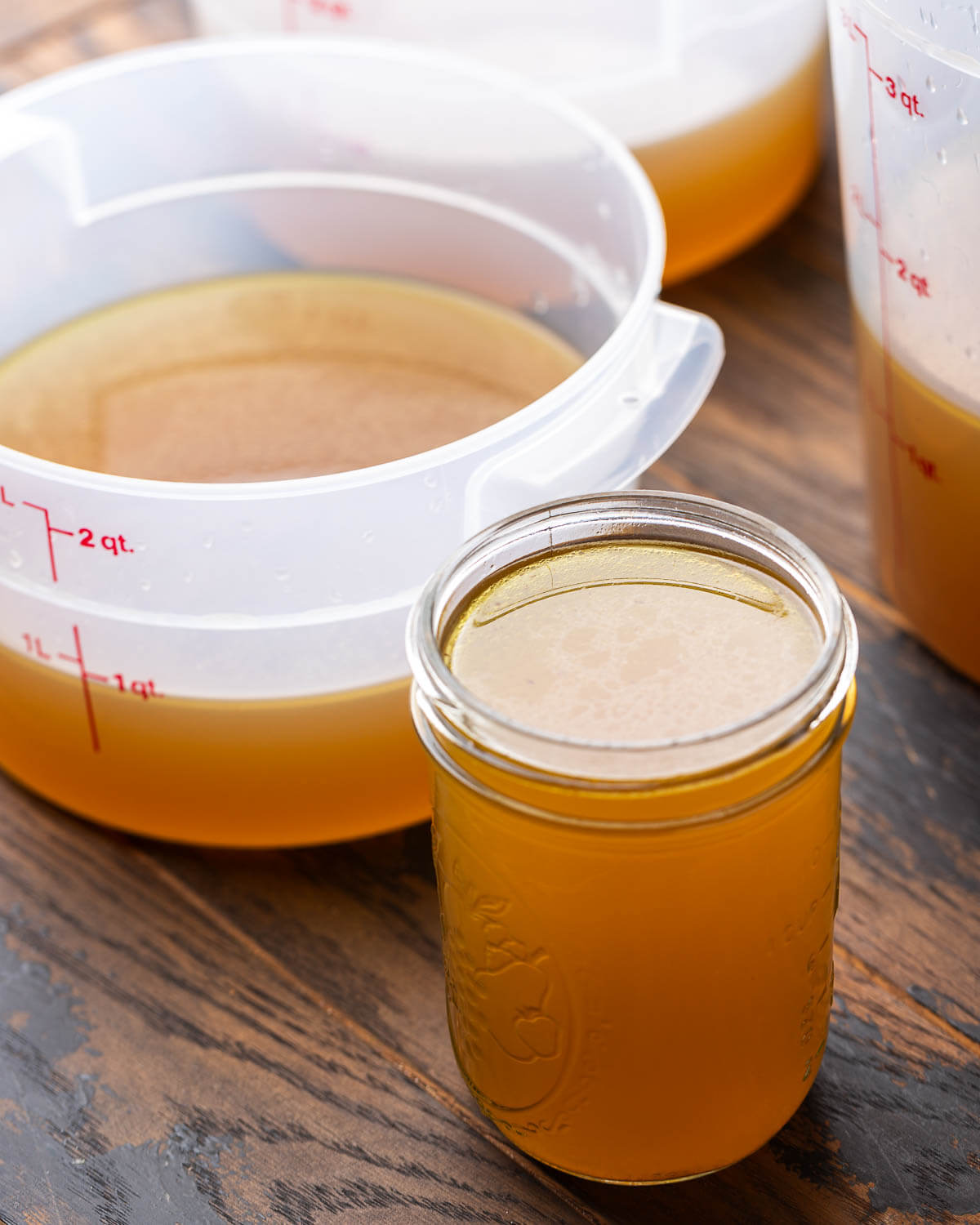
Our favorite ways to use beef stock
Many of our recipes include beef stock as an ingredient, but here are a few of our most popular.
- Italian beef stew – with carrots, celery, mushrooms, and red wine.
- Beef barley soup – with pearl barley, carrots, and fresh thyme.
- Steak pizzaiola – chuck steaks braised with tomatoes, peppers, and mushrooms.
- French onion soup – the classic topped with baguette and gruyere.
- Meatloaf with brown gravy – with garlic, thyme, onion, and the best mushroom gravy.
If you’ve enjoyed this beef stock recipe or any recipe on this site, give it a 5-star rating and tell us about it in the comments below.
We strive to satisfy a number of learning styles. If you are someone who prefers to learn by watching, you can find most of our recipes on YouTube and our Facebook Page.
Beef Stock
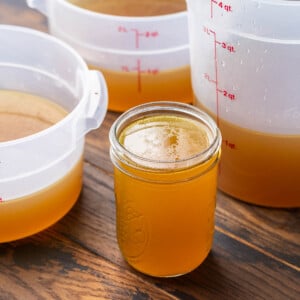
Ingredients
- 5 pounds beef bones for stock or a combination of knucklebones, oxtails or saved thick beef or veal bones with lots of marrow see below
- 3 tablespoons olive oil
- 2 large carrots cut into 3-inch pieces
- 3 ribs celery cut into 3-inch pieces, use leaves too
- 2 medium yellow onion cut in half
- 5 cloves garlic
- 2 dry bay leaves
- 1 bunch flat leaf parsley
- 15 peppercorns
- 10 sprigs fresh thyme
- 1 tablespoon white vinegar
- water approximately 8 quarts but use enough to fill above all ingredients
Want To Save This Recipe?
Instructions
Roast the bones
- Preheat oven to 425f and set the rack on the middle level. Place the beef bones on a baking sheet (use two if overcrowded) and drizzle the olive oil on the bones. Using your hands coat the bones with the oil.
- Roast the beef bones for 1 hour, turning the bones at the halfway point.
- Once the bones are roasted, place them into a 16-quart or larger stockpot.
Deglaze the roasting trays
- Pour off the fat from the sheet pan.
- Place the empty beef roasting sheet pan on the stovetop and turn the heat to medium. Add 3/4 cup of water to the pan and scrape all of the brown bits off the pans with a flat wooden spoon or a spatula. Pour all of the liquid from both pans into the pot.
Simmer the stock
- Add all of the remaining ingredients into the pot and add enough water to cover all of the ingredients. Bring to a boil over medium-high heat.
- Once boiling skim the scum from the top with a large flat spoon or ladle. Turn the heat down to a very low level where the stock is very gently simmering.
- Simmer for 9-10 hours, skimming the scum every 45-60 minutes.
Straining the stock
- After 9-10 hours the stock will have reduced substantially. Turn off the heat and strain the stock. Place a sieve or colander over an empty pot and line it with cheesecloth or coffee filters.
- First, gently remove most of the bones and vegetables from the pot then pour or ladle the stock (a small pot with a long handle works well as a big ladle) into the cheesecloth-lined strainer.
- You should be left with approximately 4 quarts of stock. If you have substantially more than that simply reduce the stock in a pot before storing.
- Let the stock cool then divide into storage containers. After refrigerating or freezing the solidified fat will be at the top of each container, protecting the flavor of the stock. The fat can be saved for another use or easily removed and discarded right before using. See below for storage notes.
Notes
- This recipe makes approximately 4 quarts of beef stock. If you have substantially more than that, the stock will be too weak. Pour the stock into a clean pot and reduce until down to 4 quarts before storing.
- Beef neck, shin, oxtail, ribs, and knuckle all work well for beef stock. You can use a variety of bones or any of these and achieve great results.
- We recommend no salt in stocks. Salt accordingly, when using stocks to make your desired recipe.
- Storing in smaller containers is recommended. 1-quart containers are how we typically store stock. But smaller amounts can be stored in ice cube trays or other smaller containers.
- Stock turns to jelly in the fridge? That is perfectly normal, and good. It means you extracted the gelatin from the beef bones.
- The stock can be stored in the fridge for up to 5 days or in the freezer for up to 6 months.
- It’s best to leave the fat cap during storage, since it provides a protective seal at the top of the container which locks in the flavor. Simply remove the fat cap upon use, or save the fat for another use.
Nutrition
Nutrition information is automatically calculated, so should only be used as an approximation.
Follow Me

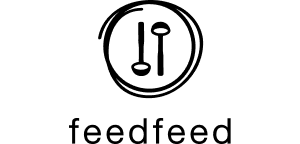



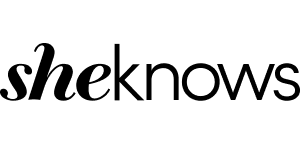
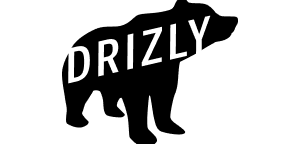
Jim, when you’re simmering this, do you have it covered or uncovered? Thanks.
Hi Dee, it’s uncovered. Hope you enjoy!
Have you ever canned the broth?
Hi Thelm, no, we haven’t canned the stock, but we do freeze it.
Very good tips, adding vinegar to the stock great idea. Thanks !
Hi I just looked at the pictures and read that part of the recipe and seen you discard the fat. I asked what you do with the fat so I got the answer thanks anyway to you and your team. I will try you prime rib roast recipe looks good. Thanks again.
Hi in your beef stock recipe you write after baking the bones in the oven pour off the fat, do you pour the fat into the pot you will make the stock in or do you discard the fat. Thanks Merry Christmas.
Hi Ravinder, after baking the bones, pour off and discard the fat, then add water to the pan and scrape off the brown bits and pour that into the stock pot. Merry Christmas to you too!
Can you use a crockpot?slow cooker to do this? Would i boil it first in a pot then put it in the crockpot or just start it in the crockpot on high then switch to low when it boils?
Hi Debbie, we haven’t tested this recipe in a crockpot so can’t say for sure. We recommend using a large stock pot since there this recipe yields a lot of stock.
I noticed you did not remove the onion skin. Why?
Hi Celeste, onion skin contributes to the color of the stock. Thanks for the question!